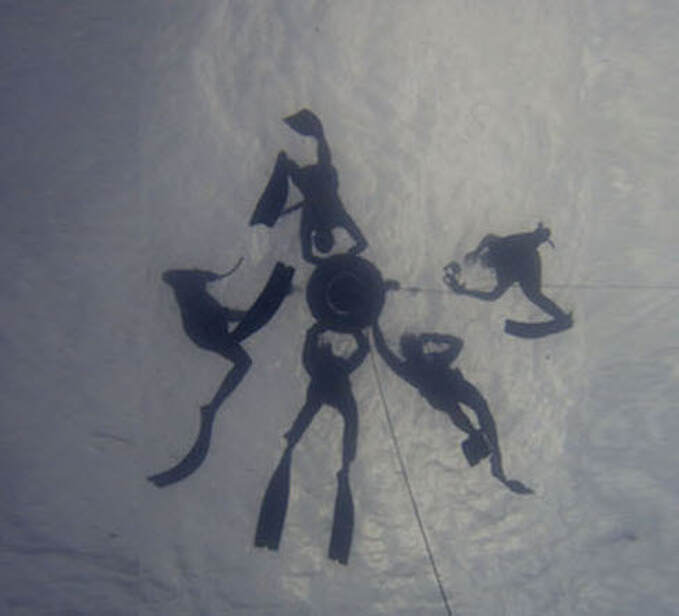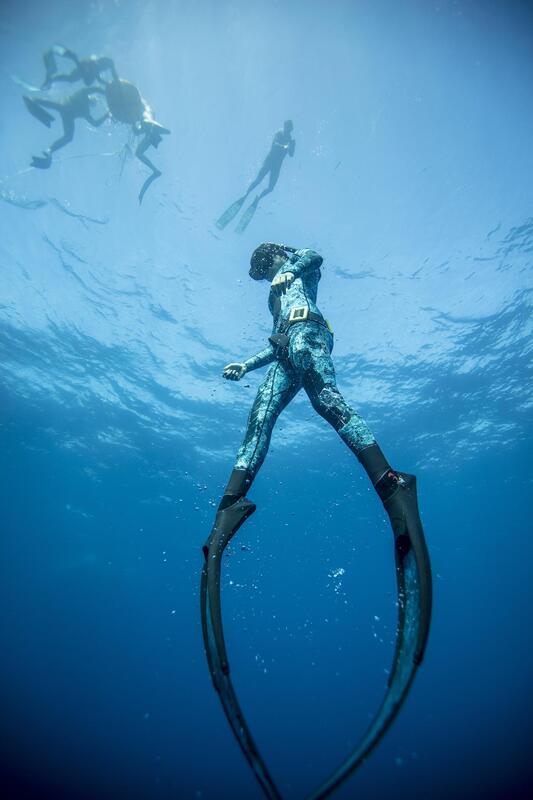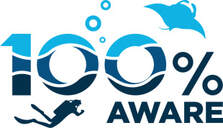 Freediving gear is simply core dive equipment designed to enhance your breath-hold diving capabilities. There is a lot of great freediving gear on the market, so find what fits you and just go dive. Find a local freediving instructor, and learn how to be a better and safer diver. Get out there, and enjoy what Mother Nature has to offer. Notwithstanding this recent popularity, freediving is the oldest form of diving. The core gear hasn't undergone any major revisions lately — it still consists of a mask, a snorkel, fins, a wetsuit and a weight belt — but there have been subtle changes that have led to exponential evolutions in the sport. Most notable among these are the design and materials of the fins. Fins The most recognizable element of freediving gear is those crazy long fins. Long blades are very efficient with a slow, steady kick. The length adds to the flex and responsiveness of the blade, creating a perception of propulsion with less effort. Many freedivers believe long fins offer the best balance between low effort and high thrust. Less effort means conserving energy and oxygen and, thus, extending dive time. While long-blade fins could be used in scuba diving, they can be unwieldy and aren't designed to maximize torque, which can be a handy feature to scuba divers for starting, stopping and maneuvering while wearing their much bulkier equipment. Long fins offer the greatest potential benefit to streamlined freedivers, who often seek to cover long vertical distances relatively quickly compared to gear-laden scuba divers. Fin blades are made of plastic, fiberglass or carbon fiber. Plastic blades are easy on the pocketbook and extremely durable, but they are heavier than and typically not as responsive as the others. Fiberglass blades are more responsive and lighter, and they are in the middle of the road in terms of price. Carbon-fiber blades are superior in performance and are the most lightweight of the three, but they are also the priciest. There are also options for blade stiffness. In most cases these are classified as soft, medium and hard. The desired stiffness will be a product of individual fitness, body weight and the type of freediving that suits you. Most long blades on the market come with full-foot pockets. A full-foot pocket that fits correctly will transfer energy better than an open-heel design. Some fins feature interchangeable foot pockets that allow you to replace a broken blade or match the best-fitting foot pocket with your favorite blade. Fin rails are another feature to be aware of — rails help keep the blade straight through your kick cycle, improving efficiency. Some freedivers choose to channel their inner mermaid and use a monofin. As with bifins, monofins are available in a range of materials and degrees of stiffness. Maneuverability is greatly compromised with a monofin, however, making these best suited to either competitive diving or recreational depth diving. Masks and Snorkels The masks and snorkels used in freediving are designed to maximize breath-hold performance. A low-volume mask is preferable for breath-hold diving because it takes less air to equalize at depth, which conserves oxygen. The lower profile also means improved hydrodynamics. Some divers prefer low-volume masks simply because having the glass closer to your eyes can make for great peripheral vision. With regard to a snorkel, a basic "J" style with no purge valve tends to work best. They are simply less bulky, and more streamlined means more efficient. See a trend here? In freediving the snorkel is spit out before descent to prevent it from keeping the airway open in the event of a blackout. Open-Cell Wetsuits Most wetsuits are neoprene with a nylon or Lycra liner on the inside and outside. Open-cell suits, which are favored by freedivers, don't have a liner on the inside, which increases flexibility. This enhanced flexibility allows divers to "breathe up" with less restriction on the diaphragm. Breathing up is the process of preparing yourself for a dive while breathing through your snorkel at the surface. Steady breathing from your diaphragm will help you relax and slow your heart rate before you take your peak inhalation and make the dive. Because they lack an inner lining, open-cell suits stick to you like glue and keep you warmer than fully-lined suits. Open-cell suits are more fragile, however, and require lubrication to put on. Don't be intimidated by the lube, it actually makes donning an open-cell suit even easier than putting on a conventional suit. Most open-cell suits are two pieces, including a top with an attached hood and a bottom. The hood enhances both warmth and hydrodynamics. Weight The final piece of core freediving gear is the weight belt. Most freedive weight belts are made of rubber. The elasticity of the rubber allows the belt to stay snug at depth so it doesn't slide around as the wetsuit compresses. Simply snug up the belt low on your hips so it doesn't impede breathing up, and you're good to go. Freedivers generally prefer one-pound weights, which allow them to fine tune the amount of weight worn. Overweighting is a serious problem and has caused many freediving fatalities. We know this because dive computers from deceased divers showed that in 90 percent of cases the diver blacked out on the surface and then sank to the bottom after exhaling during the blackout process. If weighted properly, a diver will maintain position on the surface even after exhalation. Many freedivers aim to be neutrally buoyant at 33 feet. This allows the diver to make it to the surface in most blackout scenarios, and it makes for increased buoyancy at the end of the dive when oxygen supplies are low. Computer A nice addition to your freediving gear is a dive computer that features an apnea (breath-hold) mode. The apnea mode will time your surface interval and, if used correctly, help ensure you allow enough time for your body to restore precious oxygen between dives. The majority of computers with apnea modes log dive time, depth, maximum depth and water temperature.
0 Comments
|
Jesse Dubois
Enviromentalist Freedive Coach INSTRUCTOR TRAINER Archives
February 2024
|

 RSS Feed
RSS Feed





